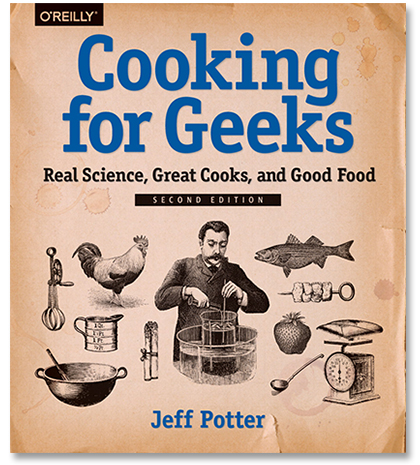Cooking for Geeks (2nd Edition), book review: A tasty second helping


Cooking for Geeks, second edition • By Jeff Potter • O'Reilly Media • 488 pages • ISBN 978-1491928059 • $39.99/£26.50 (paperback)
Why does popcorn puff out when it pops? Why do so many recipes say "bake at 350F/200C (fan oven 180C)" that I refer to it as the 'universal cooking temperature'? Why does food cook faster in a pressure cooker? Why can you spread butter without melting it? If you want to know why you have to follow some recipes exactly and when you can go off-piste and improvise safely, you need to understand the chemistry of cooking. And if that sounds like hard work, take a look at the second edition of Cooking for Geeks, which manages to turn the chemistry and algorithms of cooking into something both fascinating and tasty.
You can start at the beginning, with an explanation of why recipes matter and tips on how to experiment. This includes a potted history of cookbooks and recipe styles, instructions for calibrating your oven by melting sugar and the reason why onions make you cry. This is followed by a chapter on taste, in which we learn that cats can't taste sugar, artichokes make everything else taste sweet, food does taste different on planes and there really are tastebuds for savoury, umami flavours. Potter looks at unusual flavour combinations -- including those created by machine learning, and gives a strawberry, pickle, fish taco recipe from the Watson cookbook. His conclusion is more 'try it, it might work' than 'let the machines take over the recipes'.
The more traditional approach to cooking is in two sections, both of which have the same generous (and slightly scattergun) mix of intriguing facts, technical explanations, anecdotes, interviews, tips and recipes. 'Time and temperature' covers how food gets from raw to cooked, including: roasting quartered Brussels sprouts as a way to make them more popular; cooking fish inside a mound of salt to keep it moist and protect it from the heat; the chemistry of oils and chocolate; food safety; the intricacies of eggs, collagen and starch (meat and vegetables to the less chemically oriented of us); and how the Maillard reaction that makes food including both sugar and protein go brown and delicious happens at 310F/154C. To get the food in a domestic oven to that temperature, turn your oven to -- yes, 350F or 180C... 'Air and water' covers every area of baking from yeast to egg whites (and no, baking soda and baking powder aren't the same thing).
Hardware and chemicals
The second half of the book is even geekier, with sections on hardware and chemicals. Chemicals covers traditional options like enzymes (as used in cheese-making), pickling and preserving, and thickeners like cornstarch and agar, as well as the more exotic chemicals used for molecular gastronomy like lecithin (foam and mayonnaise), methylcellulose (hot marshmallows) and maltodextrin (turning butter or peanut butter into powder).
The hardware section covers standard kitchen equipment (microwaves and pressure cookers), exotic kitchen equipment, like the blowtorch that's ideal for caramelizing the top of crème brûlée or using a cream whipper to improve microwave cakes, and really exotic gear, like liquid nitrogen ice cream (with enough safety tips to make it less likely you'll kill or injure anyone), dehydration, extra-hot ovens for pizza, dry-ice powered chilling surfaces, centrifuges, concrete mixers (for a 500-pound doughnut), poaching apples in the dishwasher and DIY sous-vide. Even if you're never going to try some of the more complex setups, the principles are intriguing. For instance, if you don't have a centrifuge, try freezing your liquid and letting it drip through a filter as it thaws.
The original version of Cooking for Geeks was an inspiration to explore food by explaining why cooking works the way it does. Saying there are '150 new pages' undersells the second edition: a third of the book is brand new and two thirds are completely rewritten, with more details and some new discoveries, plus experiments that seem designed to get kids interested in food. There are more recipes (from medieval apple-and-fig pie to that 500-pound doughnut), more interviews, more science, more geekery and more cooking. Even if you have the first edition on the shelf, you'll want this update too.
More book reviews